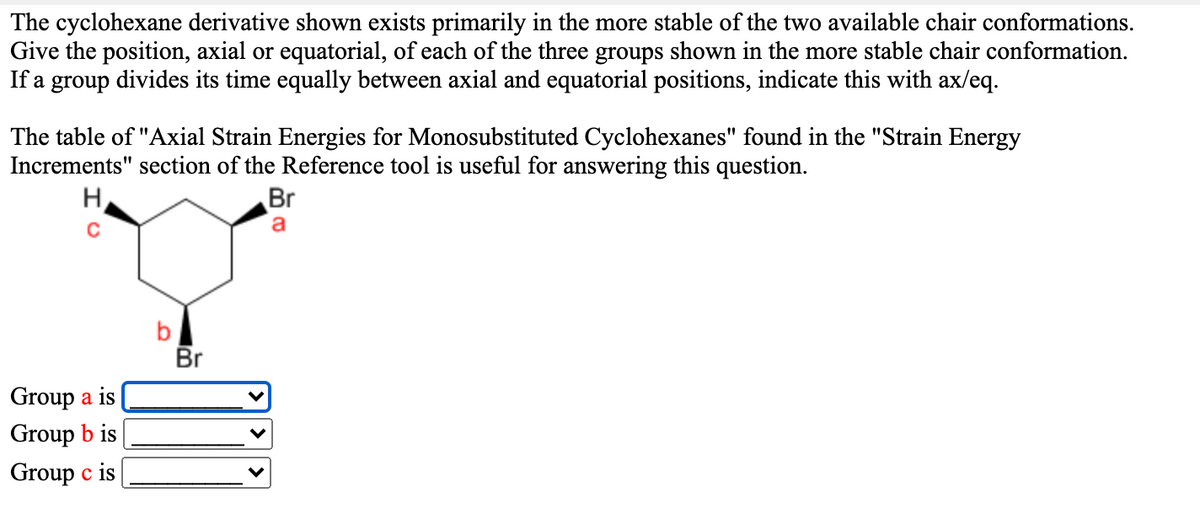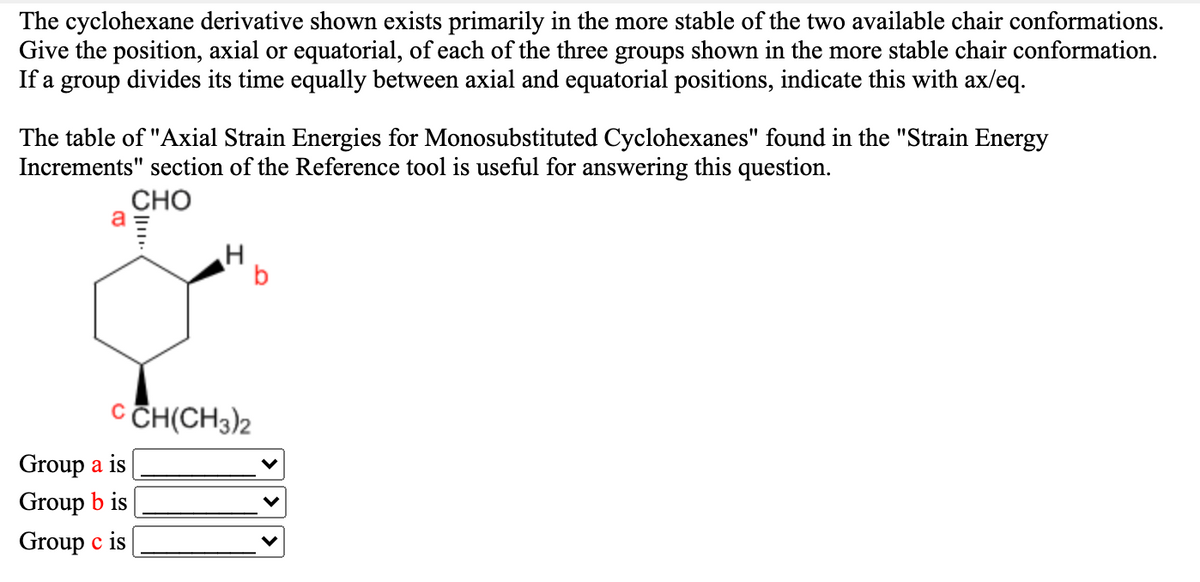The cyclohexane derivative shown exists primarily in the more stable of the two available chair conformations. Give the position, axial or equatorial, of each of the three groups shown in the more stable chair conformation. If a group divides its time equally between axial and equatorial positions, indicate this with ax/eq. The table of "Axial Strain Energies for Monosubstituted Cyclohexanes" found in the "Strain Energy Increments" section of the Reference tool is useful for answering this question. Br a Br Group a is Group b is Group c is
The cyclohexane derivative shown exists primarily in the more stable of the two available chair conformations. Give the position, axial or equatorial, of each of the three groups shown in the more stable chair conformation. If a group divides its time equally between axial and equatorial positions, indicate this with ax/eq. The table of "Axial Strain Energies for Monosubstituted Cyclohexanes" found in the "Strain Energy Increments" section of the Reference tool is useful for answering this question. Br a Br Group a is Group b is Group c is
Organic Chemistry
8th Edition
ISBN:9781305580350
Author:William H. Brown, Brent L. Iverson, Eric Anslyn, Christopher S. Foote
Publisher:William H. Brown, Brent L. Iverson, Eric Anslyn, Christopher S. Foote
Chapter2: Alkanes And Cycloalkanes
Section: Chapter Questions
Problem 2.45P: Gibbs free energy differences between axial-substituted and equatorial-substituted chair...
Related questions
Question
label the groups as axial or equatoral or both.

Transcribed Image Text:The cyclohexane derivative shown exists primarily in the more stable of the two available chair conformations.
Give the position, axial or equatorial, of each of the three groups shown in the more stable chair conformation.
If a group divides its time equally between axial and equatorial positions, indicate this with ax/eq.
The table of "Axial Strain Energies for Monosubstituted Cyclohexanes" found in the "Strain Energy
Increments" section of the Reference tool is useful for answering this question.
H
Br
a
b
Br
Group a is
Group b is
Group c is

Transcribed Image Text:The cyclohexane derivative shown exists primarily in the more stable of the two available chair conformations.
Give the position, axial or equatorial, of each of the three groups shown in the more stable chair conformation.
If a group divides its time equally between axial and equatorial positions, indicate this with ax/eq.
The table of "Axial Strain Energies for Monosubstituted Cyclohexanes" found in the "Strain Energy
Increments" section of the Reference tool is useful for answering this question.
CHO
a
C CH(CH3)2
Group a is
Group b is
Group c is
Expert Solution
This question has been solved!
Explore an expertly crafted, step-by-step solution for a thorough understanding of key concepts.
This is a popular solution!
Trending now
This is a popular solution!
Step by step
Solved in 3 steps with 2 images

Knowledge Booster
Learn more about
Need a deep-dive on the concept behind this application? Look no further. Learn more about this topic, chemistry and related others by exploring similar questions and additional content below.Recommended textbooks for you

Organic Chemistry
Chemistry
ISBN:
9781305580350
Author:
William H. Brown, Brent L. Iverson, Eric Anslyn, Christopher S. Foote
Publisher:
Cengage Learning

Organic Chemistry
Chemistry
ISBN:
9781305580350
Author:
William H. Brown, Brent L. Iverson, Eric Anslyn, Christopher S. Foote
Publisher:
Cengage Learning